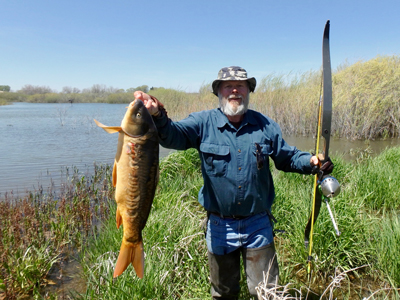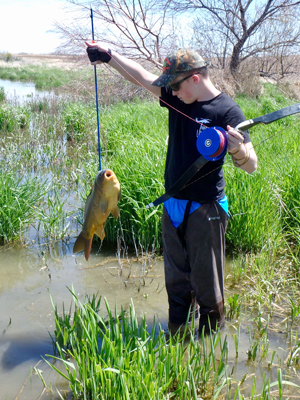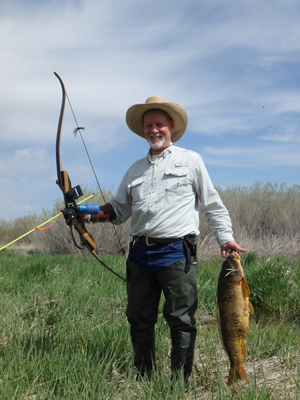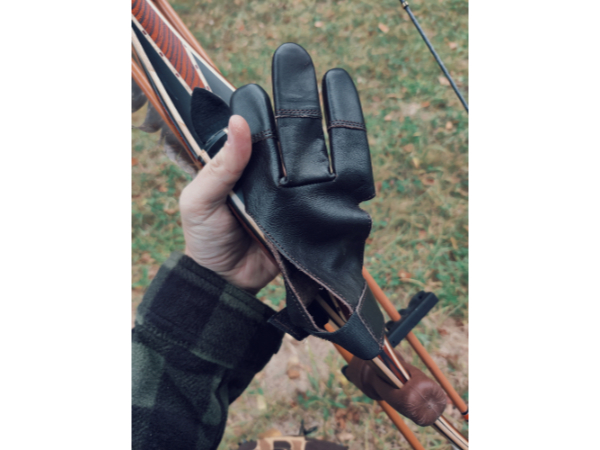I heard the moist-sounding “thunk” and knew what would come next. Yep, there it was, the frustrated exclamation, “Poppa, I missed again!” I was trying to teach my grandson, Jake, how to shoot carp with a bow. He was a pretty good shot with his Bear Super Mag, but the carp were getting the best of him. It didn’t help matters that he had watched my hunting and fishing buddy, Dave Stanley, and I shoot several that afternoon.
Jake’s struggles gave me pause to think back to my start in bowfishing. My dad took me fishing when I was about three-years-old, and not long after that he made me my first bow, a rather simple stick and string affair that opened a whole new world for me. I was passionate about archery and fishing for many years, and I suppose it was only natural that those passions would eventually merge. However, that merger took decades. Carp and bowfishing for carp or any other fish were not common pursuits in the part of New England where I grew up, although carp occurred in a few large reservoirs. During one of our Friday night fishing trips, I remember Dad going back to his car for a tape measure because we found a very large carp washed up on shore and we wanted to know how large. I was impressed by the size of that fish, but that’s the only time I recall seeing a carp until many years later when I had moved out west and was working in central Washington.

The author with a large carp.
Although I had heard the term, bowfishing was unknown to me even then. It wasn’t until I finished college and ended up living in an area where carp were abundant in rivers and reservoirs that I began to learn about bowfishing and was finally able to meld my two interests.
Like me, Jake started fishing when he was about three years-old and began shooting a bow at the same age. My friend and bowyer, Reed Stewart, made Jake a kid-size longbow when Jake was about three. It wasn’t very expensive, but I consider it some of the best money I ever spent. Given his interest in fishing and bows as well as our local supply of carp, I hoped that my grandson could begin to enjoy bowfishing much sooner than I did. First, though, he had to be tall enough to safely wade the carp flats. Jake was a reasonable shot with his longbow by the time he was 10 years old. Still, I thought he had to grow some before I could introduce him to bowfishing, so I held off on my own carp shooting then mostly to resist the temptation to introduce him to an activity that he wasn’t quite ready for.
By the time Jake reached 13 years of age, he had several years of experience wading local trout streams and gained even more skill with his bow. Most importantly, he was tall enough to safely wade the carp shallows and accompany me for a favorite springtime activity. He was ready, or so I thought. I chose a nice sunny day, not too hot and with only a light breeze blowing on our local reservoir. We were joined by Dave Stanley in a back bay off the reservoir that seemed to hold quite a few carp.
The bay contained an extensive flooded flat with widespread stands of willow that tended to keep the waters calm even when the wind was blowing. It also provided us with a fairly isolated spot, because the willows discouraged folks bowfishing from a boat, since it was difficult to penetrate the screen of willows with a watercraft. Additionally, thick mats of dead bulrush stems provided great hiding places for carp and lay interspersed among the willow patches. During an earlier visit, I learned that carp commonly cruised between the bulrush and willows and could easily be intercepted by setting up between the two types of cover. In most of these areas the water did not get over two feet deep, and reasonably large numbers of carp regularly cruised these shallows. The bottom was generally firm, with a minimum of obstacles to trip over or mud to get stuck in. Water tended to be fairly clear, allowing us to see carp at some distance.
The willows also afforded us a unique opportunity for carp shooting. In places carp would lie in the willows within a few feet of shore, allowing us to stalk and shoot.
The carp here were no different than in many other places I’ve shot carp. That is, at some point the disturbance from our bowshooting activities would get to be too much and the carp would disappear for a while. That did not present much of a problem for us, because the area was large enough that we had other options for bowfishing. All in all, it appeared to be an excellent spot to teach a boy to bow fish.
When we pulled into the parking area, we could hear carp splashing in the shallows. This immediately caught Jake’s attention and he was ready to go. First things first though, and the first thing was to set up our bows and explain to my grandson how the equipment worked. Jake was both enthusiastic and anxious to try this new activity. We didn’t have to walk far from the truck before I was able to set him up in a spot I knew was on a travel lane for carp as the fish moved among different types of cover. Then I walked a few yards away and took one shot, skewering a carp to demonstrate the technique to Jake while Dave moved another 25 yards off and within a few minutes took a couple of fish.
Jake rapidly grasped the general approach of finding a spot carp like to swim through and then making like a great blue heron, waiting silently and watching carefully. He also learned that carp react badly to clumsy movements and noise when we made a splash moving into place and two nearby carp blasted out for adjacent cover.

Jake and a carp.
Most of the basics seemed easy enough but judging distance for an appropriate shot and estimating the shooting angle on a target moving through water were difficult for Jake. I tried to explain that it’s easiest to learn these fundamentals through practice, but Jake was impatient. He watched Dave and me shoot several carp, and to him it seemed easy enough. In practice, he quickly learned it was more difficult than it looked. Dave helped with some of the early instruction then wandered down the bay for a little carp spotting and stalking, leaving me to coach my grandson.
We didn’t have to wait long for Jake’s first shot at a carp, and then his second, and then his third, all misses. I don’t know how many shots Jake eventually missed before he started showing evidence of frustration. For a while I stood next to him and tried to provide some gentle coaching, talking about judging appropriate distances, shooting through water, and picking a spot just under the carp. Jake had been shooting a bow and fishing for the last 10 years. By now, he wanted some independence, not a grandfather looking over his shoulder. So, I moved 25 yards away and searched for carp on my own, occasionally offering Jake an encouraging word or two.
I was beginning to wonder if this outing had been a mistake. From years of coaching youth sports, I learned the easiest way to turn off a teenager to any kind of activity is to insist that they keep doing something that they are simply not having any success with. It’s somewhat like putting the proverbial square peg in a round hole. Conversely, if you can help the youngster succeed (and sometimes you have to stretch the definition of success) then you are more likely to produce someone who enjoys the activity and eventually becomes more skillful at it. When teaching youth how to fish, cast a fly rod, shoot a bow, or hunt, I always try to put them in a position where they can enjoy some sort of success. Today it seemed I was failing miserably, and I was seriously thinking of calling it a day. Jake had missed 11 carp and his frustration was evident. It appeared that he was no longer having much fun. I thought I would let him try one more shot before packing up the gear and going to look for ice cream. Although the carp were cooperative, it looked as if today I wasn’t going to have much success in developing a new bow fisherman.
And there it was, Jake’s familiar cry, but somehow it sounded a bit different. I had moved far enough away that I couldn’t hear him clearly and was busy concentrating on a carp swimming toward me. Looking up, I saw him pulling on his line. Initially I assumed he was tugging his fish arrow from the mud but then I finally understood his second shout, “Poppa, I got one.”
Jake had shot a fairly large carp, and the fish immediately made a beeline to the nearest patch of willows. By the time I got there, the carp along with Jake’s arrow had traveled into a thick stand of willow. It seemed incredible that a fish that large could have penetrated such a thicket, especially with a fish arrow attached. Jake tried to work the fish out, but his efforts fell short. The carp was wedged tightly into the woody mass and Jake was left wondering if he would finally end up losing the fish he had worked so hard for.

Dave Stanley showing off one of his carp.
I always figured that one of a grandpa’s jobs is to help the grandkids overcome challenges. This definitely qualified as a challenge, and it appeared that overcoming it was going to require two people. The water in the willows would have flooded over Jake’s hip boots, so I told him to stay where he was while holding the line tight to prevent the carp from penetrating into the willow thicket any farther. When he was set, I waded in. Following my tortuous stretching and balancing act, a performance that would have done a yoga master proud, and with Jake’s firm grip on the line, we were finally able to free his fish from the woody growth. We then made our way to shore for photos and a quick review of why things went right this time. I could tell from his animated comments that Jake was back to enjoying himself.
This had been a learning experience for both my grandson and me. We both learned the importance of patience, and I learned the importance of providing encouragement while giving the young bowhunter some independence. I think these are essential lessons whether your quarry is a carp or an elk. It’s true that the carp were plentiful and cooperative, but this outing could have easily turned into a day of defeat and frustration for Jake. I probably would have been able to get him to try bowfishing again, but he likely would have approached a second attempt with little self-assurance and perhaps a willingness to give up early. Now, having gained confidence, Jake enthusiastically looked forward to a second trip.
Another important part of our outing was having my friend Dave Stanley along. Dave has fished and shot bows with Jake for several years and has grandchildren of his own to mentor. He understood Jake’s frustration and helped both of us by providing encouragement and showing a lot of excitement and support when Jake finally scored.
In our little part of the bay, the carp were becoming more cautious and the afternoon was fast fading. We stayed a bit longer and Jake had two more shots before we called it quits. With those two shots, he managed to hit another carp and then had a miss to end the day, but he made great progress and most importantly had fun while developing confidence in his carp-shooting ability. Ending on a miss was actually a good thing because it reminded me that Jake and I needed to discuss “misses” with carp shooting. Despite the early success Dave and I demonstrated that day, it is not uncommon for us to miss and I wanted to stress that point with Jake. Missing is not failure, it’s simply encouragement to do better the next time. Jake seemed to understand perfectly by the end of this outing.
Equipment Notes: The author used a Browning Wasp while Jake shot a Bear Super Mag. The author’s friend, Dave Stanley, carried a Samick Sage recurve. All shot standard fiberglass fish arrows.







Leave A Comment